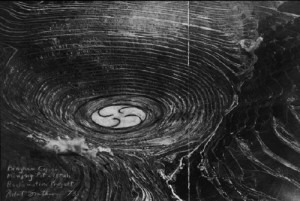
This next month I am revising and typesetting my first book of poems, tentatively titled The Hole. Writing so much criticism and essay and working a lot this past year, it has been difficult at times to hold the ms in my attention. Now that May is before me (the book is due to my publisher, the brilliant Brian Whitener of Displaced Press, June 1st) I am excited to revise, typeset, and write critically around the current draft, which I have not worked on since this past fall. Below are some notes I took in haste today about the ms.
Robert Smithson quotes Carl Andre as saying “a thing is a hole in a thing it is not.” And this is one way to think about the hole of this ms's title—as an absence or negativity which affirms the fact that nothing is something too. I am interested in the metaphysical claims of Land Artists such as Smithson inasmuch as they reflect the social strife and resistance of their day. There is a gaggle of young boys standing around Claes Oldenburg's (proto-) earthwork, “The Hole,” in Central Park circa 1967. Grave as sculpture? Is Oldenburg's grave/earthwork sculpture for the young men dying in Vietnam or is it for the artist/art itself, I wonder? Art (so-called) must 'dematerialize' because the young men are dying and because they are commanded to kill innocents. The artist can’t help but feel some complicity in this (the Vietnam era as the dawning of a new age of complicity with Empire). I am not nostalgic for the Vietnam era (my parents' generation). But it still presents my generation (I am nearly 33) with a think tank for aesthetic politics and live dynamics. Then again, negativity/absence has long been recognized as a site of possibility and potential. Destruction was Mallarmé's Beatrice, moving words or dirt as dead metaphors the land artist’s. The dead/dead metaphors keep piling-up (late late Modernism). Post-Modernism (so-called) awakens to this fact. I often feel like I am shouting into a void but then, lo and behold, someone hollers back. In an age of the virtual, community, friendship, and collegiality is echolocated despite the immediacy of communication, what the artist Paul Chan calls the "tyranny of connectedness." I am you in negative. Words are left over from what would be called 'we' or 'us' (anything approximating communalism/commons/group identification). The hole as what is left over from the whole (totality). The hole as the positive value assigned to social antagonism, discrepancy, shame, abjection, despair. The sublime despair that equal signs don’t in fact add up, that they should be under erasure, that disparity crowns the attempt to be among (a kind of garland). The poet laureate should wear such a garland. When we think back on the aughts what will be remembered? "W" and co., Iraq, Katrina, ecological despair, the road to torture, the false redemption of "Yes We Can." At the clip of mediation, 'my' voice—sans appropriation except for an uncited line here and there—is subtracted from any number of social facts, events—event as the people I have loved/been with/cared about. Lyric won’t die because there are still bodies and we suffer these bodies beyond conceptualization at a limit where individual touches multitude. The world is not totally administered, not a discursive machine, not totally, yet. Affect subtracted from emotion might make a collective subject. Lyric is (still) a site for collective subjects. Rhythm (the words as they find rhythm) and "sonic substance" (Fred Moten's term) as a kind of marsh or phylum for the vita activa. The hole is what 'I' am digging and what digs 'me,' literally. Against expropriation lyric radicalized observes the fact of dirt moved. Dirt as property relation. Dirt as money (abstraction of social wealth). Dirt as what remains after irresponsible corporate-industrial behavior—strip mining, oil spills, deregulation of toxicity. How to sing this except through a tortuous and straining syntax? Somatic sublimation and decreation. Elaine Scarry’s The Body in Pain appears to me one of the eras most cited books because world unmaking is a vital response to ‘development,’ not using as much important as a committed attention to how we use (Augustine's apocryphal "they should have used the world without using it," cited by Robert Kocik; William Cronon's similar articulation in his essay, "The Trouble With Wilderness"). So is the hole what remains after remediation or before it? I think it is what remains period as inequality, unassimalibility, radical loss (Judith Butler’s “loss has made a tentative ‘we’ of us”; the angelic potentia of kari edwards’ late poetic). Art and anti-art, poetry and anti-poetry can still make visible what is under the radar of the visible, legible, codified, comprehensible. This is its active (activist?) function. Lyric produces immediacy through mediated sensibility (Adorno). “Starsongs of [dis] possession” (Robert Duncan) or "disaster lyrics" (Rob Halpern). Lyricism entangled at the edges of rhetorical strategy, quietude, neo-surrealism, and proceduralisms.
Thom Donovan lives in New York City where he edits Wild Horses of Fire weblog (whof.blogspot.com) and...
Read Full Biography

